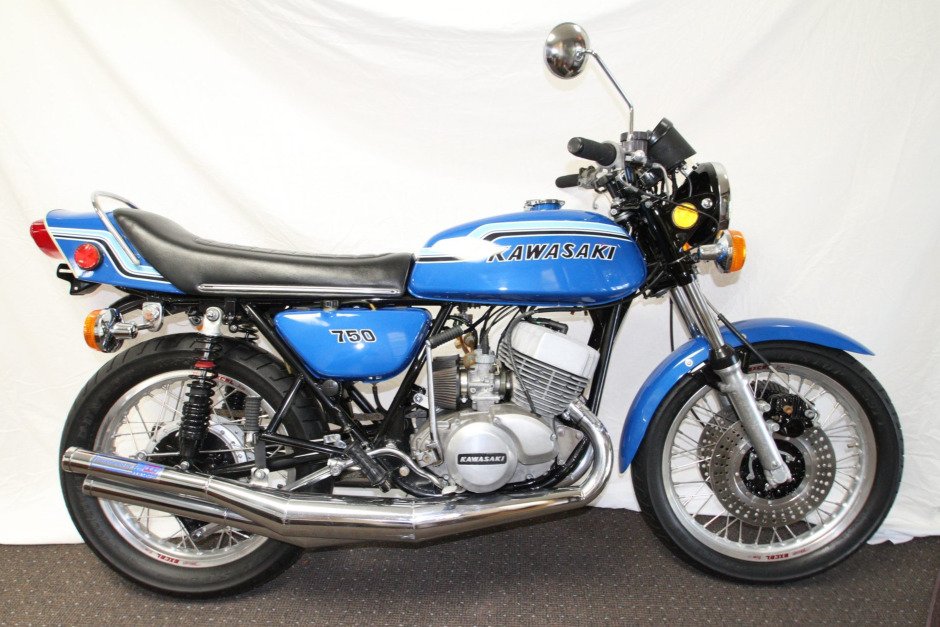1972 Kawasaki H2 Mach IV 750 motorcycle


Quickest Production Motorcycle of the Early 70s.
Outstanding straight-line performance.
In line 3 Cylinder Two Stroke 750cc engine with triple carburetors.
The Kawasaki 750 H2 shown here in Blue was a performance-oriented motorcycle that paired a three-cylinder 2-stroke engine with individual carburetors to a lightweight tubular steel frame to meet the needs of the muscle bike craze of the 1970’s. Throughout the 1960s Kawasaki Heavy Industries manufactured middleweight and small-displacement motorcycles typically with single and twin-cylinder two-cycle engines. Reliable and inexpensive, they positioned themselves in a marketplace next to Suzuki and Yamaha offering both on and offroad bikes. Performance-wise, they were the equal of larger bikes offered by US, British, and European manufacturers but their real competition in the marketplace came from other Japanese offerings. In 1968, Honda introduced its groundbreaking 4-cylinder 750cc CB 750K 4-stroke bike, setting the tone for other Japanese motorcycle manufacturers to play catch up in the performance wars. Kawasaki took on Honda in ’68 with an all-new 3-cylinder 500cc H1 Mach 1 using a two-cycle piston port engine, electronic CDI ignition, sports styling, and a very competitive purchase price. The H1 sold well but Kawasaki knew that it wasn’t enough. Bigger was better and a 4-cylinder, 4-stroke street bike that could outperform the Honda was several years away in development.
The only way Kawasaki could compete on equal footing to Honda and the new GT750 3-cylinder water-cooled Suzuki was to pull out the stops and build the most outrageous and powerful 750 they could. Both Kawasaki and Yamaha had produced 2 cycle race motorcycles for international road racing competitions, and Kawasaki drew from the technology found on the track to package their new machine with a fast revving 3-cylinder air-cooled powerplant that could out-accelerate any bike on the street. In the American market, drag racing was a popular sport for spectators and participants alike and it fueled the muscle car craze of the 60s and early 70s. Motorcycles also established themselves as inexpensive performance machines at the racetrack and soon quarter-mile times became a major selling point for buyers hoping to have the fastest time to win on the street and the drag strip. Kawasaki 750 H2 machines became the bike of choice as the combination of lightweight, rapid acceleration, and a growing aftermarket accessory speed parts market gave riders a good platform for racing. A racing-inspired seat with an aerodynamic tail cowling allowed riders to slide back on the seat to reduce wind resistance. The sound of the engine under power gave an unmistakable “howl” followed by a stream of pungent two-stroke smoke out of the triple tailpipes.
The Kawasaki H2 did have several drawbacks. While it offered high horsepower, the power delivery was abrupt and often resulted in spectacular wheel stands that could send the front wheel skyward. Additionally, if the bike was to deviate from its straight-line acceleration, the lightweight frame, narrow tires, and undersized suspension components could result in a speed wobble that could be very difficult to control at high speeds. As such, all H2 motorcycles were outfitted with a hydraulic or friction steering damper to reduce front-end shake at speeds. Serious riders often added twin-disk brake systems to augment the single disks installed as standard equipment. To provide even more acceleration and top speed, tuned expansion chamber exhaust systems could be fitted along with free-flow air cleaners to get the most from the motor. To keep weight down, the H2 was kick start only and lacked an electric starter.
The bike on display shows many of the popular enhancements that were typical of H2 street machines of the time. Tuning the engine to peak performance could be challenging yet rewarding to H2 owners. The H2 stayed in production until 1975 but its place as the Kawasaki flagship motorcycle came to an end with the arrival of their 4-cylinder 900cc Z1 in 1973.
Specifications
Engine: 748cc 3-cylinder 2-cycle with oil injection, 3 Mikuni Carburetors, CDI electronic Ignition
Transmission: 5-speed manual
Horsepower: 74 hp
Performance: Standing ¼ Mile 12.0 seconds
Top Speed: 120 mph
Weight: 422 lbs

